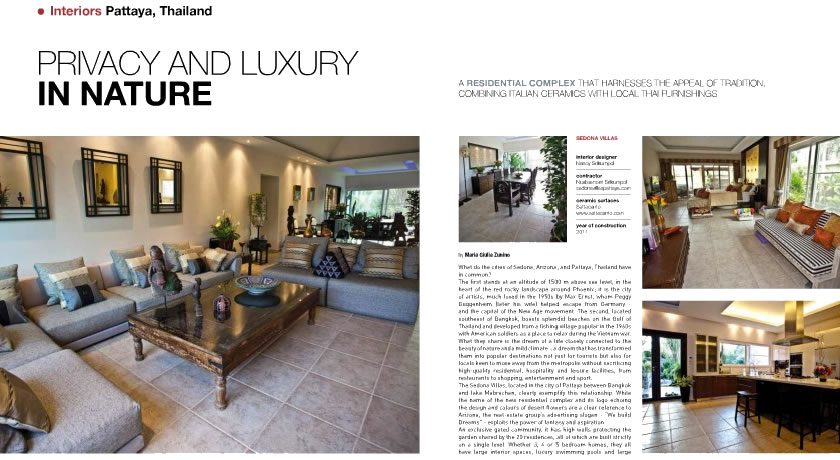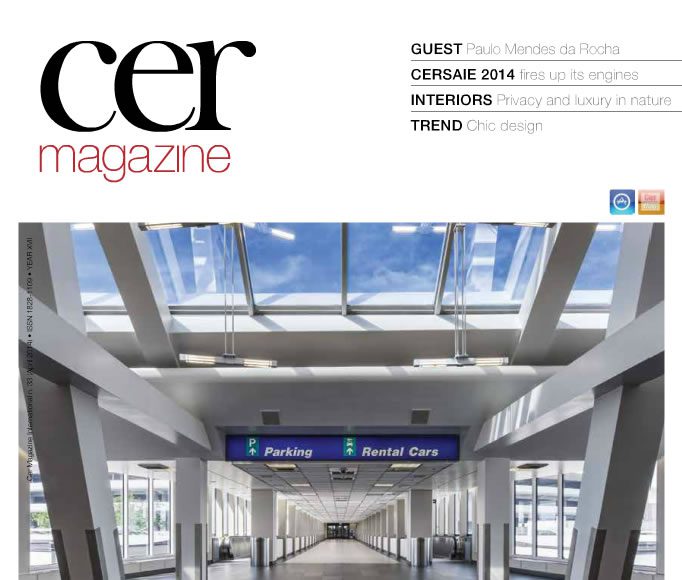Issue number 33
Privacy and Luxury in Nature
A residential complex that harnesses the appeal of tradition, combining Italian ceramics with local Thai furnishings
by Maria Giulia Zunino
What do the cities of Sedona, Arizona, and Pattaya, Thailand have in common?
The first stands at an altitude of 1500 m above sea level, in the heart of the red rocky landscape around Phoenix; it is the city of artists, much loved in the 1950s by Max Ernst, whom Peggy Guggenheim (later his wife) helped escape from Germany – and the capital of the New Age movement. The second, located south east of Bangkok, boasts splendid beaches on the Gulf of Thailand and developed from a fishing village popular in the 1960s with American soldiers as a place to relax during the Vietnam war. What they share is the dream of a life closely Connected to the beauty of nature and a mild climate… A dream that has transformed them into popular destinations not just for tourists but also for locals keen to move away from the metropolis without sacrificing high-quality residential, hospitality and leisure facilities, from restaurants to shopping, entertainment and sport.

The Sedona Villas, located in the city of Pattaya between Bangkok and Lake Mabrachan, clearly exemplify this relationship. While the name of the new residential complex and it’s a logo echoing to design and colors of desert flowers are a clear reference to Arizona, the real estate group’s advertising slogan – “We built dreams” – exploits the power of fantasy and aspiration.
An exclusive gated community, it has high walls protecting the garden shared by the 20 residences, all of which are built strictly on a single level. Whether 3, 4 or 5 bedroom homes, they all have large interior spaces, luxury swimming pools and large Windows that allow natural light to plug in and provide use of the lush tropical vegetation. Rather than being relegated to their traditional functional role, the kitchens and bathrooms feature some splendid design solutions, such as the bath set between two windows looking out onto a small private garden.
The interior design project is based on a model that has proved popular the world over, combining the universal desire for comfort with the elegance of tradition.
But tradition and elegance are words that immediately make one think of Italy and Italian products.
Nancy Srikumpol – the interior designer responsible for the project – is a strong advocate of Italian design and in these villas wanted to re-create the atmosphere of a timeless, rustic-classic Italian home. To do this, she chose the ceramic floor tiles from Settecento Mosaici e Ceramiche d’arte, a company that has innovated Italian tradition while remaining true to experience and has exported it all over the world. In particular, by choosing tiles from the Azteca glazed porcelain collection with a slightly rough surface in the classic 49 x 49 cm size (neither small nor excessively large) and laying them with traditional wide joints, the interior designer reproduced the internationally recognized image of an Italian holiday home. The resultant floor surface is not just hard-wearing and easy to maintain, above all it is highly versatile and adapts well to different spaces and applications, exteriors included, and coordinate well with a wide array of materials such as marble and wood, as well as furnishings of various kinds.
The furnishings themselves are dominated by the local wood-working tradition and include tables and chests of drawers carved with floral motifs, oriental-style painted furniture, small sculptures of deities, and even an astonishing billiard table with curved legs. Although often borderline kitsch, the wealth of decorations page should be to one of the symbols of Pattaya, the Sanctuary of Truth, which millionaire Khun Lek Viriyaphant wanted to be an all-wood building to preserve Thailand’s culture and history.
article from Cer Magazine International


